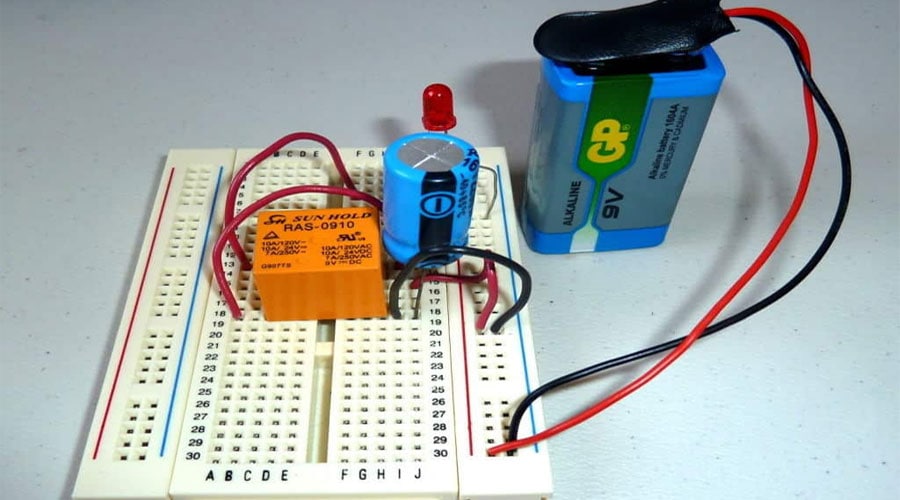In many different kinds of applications for electrical circuits, a pause lasting a few seconds or even a few minutes becomes an essential prerequisite for assuring that the circuit will work properly. In the absence of the required delay, the circuit might not function properly or perhaps become destroyed.
Within the realm of electric power, a time relay is a useful tool that may be put to a number of different applications. It is the optimal method for effortlessly controlling power as well as automation. It is possible to utilize it for everything, from switching on lights in your home to managing the power outlets in your home.
In this article, we will explore the function of the time delay relay, as well as its operation and several useful applications. Continue reading if you are interested in finding a simple method to automate the operations of your house or business.
What Exactly is a Time Relay?
A type of device known as a time relay delay is one that makes use of an electromagnet in order to regulate the flow of power through a circuit. The apparatus consists of a coil of wire that is wrapped around an iron core in a spiral fashion. A magnetic field is produced in the electromagnet as a result of the flow of electricity through the circuit.
Within the apparatus, this magnetic field has the ability to either attract or repulsion another magnet that is attached to a relay timer switch. You will have the ability to control when this takes place by adjusting the amount of time that the current is allowed to flow through the time relay’s coils before it is cut off.
How Exactly Does the Time Delay Relay Function?
The timer relay switch operates based on the principle of electromagnetism. One relay coil is always on, while the other may be turned off and on by sending an electric signal through it from a control device such as a phone or computer system. One relay coil is always on, while the other can be turned off and on by sending an electric signal through it. The “on” coil is always connected to a source of power, so it is always prepared for operation at a moment’s notice.
When the device is turned on, the “off” coil is the only part of the circuit that receives power. Once powered up, it works to pull in an armature, which in turn activates the other end of the circuit where electricity flows. This armature will return to its starting position as soon as the power is shut off, which means that it will no longer let electricity flow through the circuit.
Applications of a Time-Delay Relay
Time delay relays are extremely versatile and can be put to use for virtually any activity that may arise. The following are some examples of common applications for the time delay relay:
1. Managing the Many Power Outlets
By utilizing two relays to alternately switch on and off the flow of energy, you can exercise control over a power outlet. When you plug something into the outlet, one relay controls “On,” and another relay shuts it off once the device that was plugged in has finished charging or supplying power to whatever gadget was plugged in.
2. The Turning on of the Lights
Turning lights on and off is one of the most popular uses for a relay that is paired with a timer. The method functions by turning on the relay’s coil for a predetermined amount of time in order to activate the relay, following which the flow of electricity is stopped. This allows the lights to be turned off once more after they have been turned on. If you want the lights to turn out by themselves whenever there is no one in the room, this is the ideal solution for you!
3. Taking Command of Various other Kinds of Machines
Because so many different kinds of equipment are controlled by electricity, the time delay relay is a useful tool for accomplishing this goal. You are able to control a machine on your property, such as an air conditioning system, heater, or home entertainment system, without having to physically move across your living room. When it comes to the kinds of automated tasks you can perform using a time delay relay, the possibilities are virtually limitless.
4. Applications with a High-Performance Level
These devices are typically found in high-performance applications such as robots or equipment that demand precise timing operations. Other common uses include medical imaging and aerospace. Activating valves in pneumatic cylinders, controlling timers on coffee makers, lighting systems in airports and train stations, and even powering up surveillance cameras are just some of the applications that can benefit from their utilization.
How Should a Time Delay Relay Be Tested?
These are the following ways how to properly test your time relay:
- There is a straightforward method available to you if you need to put a time delay relay through its paces. First things first, check to see that the device is not only switched off but also unplugged from its power supply. The next step is to acquire an electrical probe or any other type of electrical testing tool that has two metal ends (one little and one large), with the intention of bringing both ends into contact with the interior of your circuit board simultaneously. Connect these probes so that each end goes in the side of the “on” coil on the time delay relay. You will need to do this before you can move on (the larger probe should be connected in between).
- If you are carrying out these steps correctly, you will be able to see a back EMF when the electric current travels through the wires and any other conducting materials, such as metals. When you move your probe from one coil to the other, this manifests itself as a momentary reversal in the direction of the flow of electricity. If it does not appear, this indicates that your time delay relay is either damaged or has a wire that is broken somewhere on its circuit board. If it does appear, this indicates that it is working properly.
- In addition to this, you can use a multimeter to examine whether or not there is continuity between the ground and each side of the “on” coil (which should be represented by two probes touching at once). If there is no internal damage to the gadget itself when you attempt to do so, you will be able to detect an audible sound. You can figure out what needs to be fixed by testing each connection on both sides until you locate the point where it breaks. Even though standard relays don’t have coils as these do, their internal switches still need to be linked correctly for the device to function properly. This procedure works just as well with regular relays as it does with coil-equipped relays.
- When working with time delay relays, it is absolutely necessary to test them properly to ensure that they function appropriately. You are able to accomplish this by testing the device’s internal connections by making use of an electric probe and a multimeter. This assists you in locating a break in your circuit board, which is vital for repairing the board in the event that it is damaged or malfunctioning.
How to Construct a Circuit using a Time Delay Relay
An electromechanical device is known as a relay switch between two terminals in an electrical circuit. In order to perform the switching function, the coil in the relay must first be energized, and then it must be de-energized. The steps to constructing a time delay relay circuit are as follows:
- This task can be accomplished by a microcontroller or another device using a very weak electrical signal. There are several specialized kinds of relays in which the switching operation for energizing and de-energizing the coil is not immediate. These relays can be distinguished by their appearance. These relays include a “Time Delay” feature that allows for some lag time between when the coil is energized or de-energized and when the armature moves. Time Delay Relays are the name given to these kinds of relays.
- A time delay relay is made up of a regular electromechanical relay and a control circuit that allows the user to regulate the operation of the relay as well as its timing of it.
- The most significant distinction between a regular relay and a time delay relay is that, in the case of a regular relay, the contacts close or open immediately when the coil is energized or de-energized, whereas in the case of a time delay relay, the contacts close or open only after the preset time interval has elapsed.
The following constitutes the necessary components:
- 12V Relay — 1
- TIP122 — 1
- 1N4728A (3.3V Zener) — 1
- 100 KΩ POT — 1
- 1KΩ — 3
- 330Ω — 1
- 1000µF / 25V — 1
- 100µF / 25V — 1
- 1N4007 — 1
- LEDs — 2
Design of the Circuit for a Time Delay Relay
Between the power source and the ground terminal, there is a series connection made using a 1K resistor, a 100K variable resistor, and a second 1K resistor. The positive terminal of the 1000 uF capacitor is connected to the wiper of the variable resistor. A connection has been made between the cathode of the Zener diode and the wiper terminal of the variable resistor.
The positive terminal of the capacitor with a value of 100 fF is connected to the anode of the Zener diode. A connection has been made between the anode of the Zener diode and the base of the transistor TIP122. The grounding conductor is linked to the negative terminals of both the capacitors and the emitter terminal of the transistor.
The Operation of the Time-Delay Relay
Electronic gadgets manufactured nowadays all employ power supply systems that are SMPS-based. These kinds of power systems are susceptible to surges in the power supply from the mains. The SMPS systems in electronic devices are easy to significantly damaged if they are subjected to an input surge current during power on or when power is resumed after a failure.
As a result, it is prudent to implement a delay of some length before supplying the gadget with power. Because of this, the potentially catastrophic consequences of voltage spikes and input surge currents are avoided.
The operation of a time delay relay will be put through its paces as a result of this project’s efforts. The Time Delay Relay is able to give a brief delay after the activation of the power supply and prior to the activation of the device.
Process Operation of the Time-Delay Relay
The operation is rather straightforward, as will be shown below:
- The RC time delay and Zener-controlled switch are the fundamental building blocks of this circuit. When electricity is supplied to the circuit, the capacitor of 1000 kilofarads (F) begins to charge through the variable resistor of 100 kilofarads (K).
- When the voltage across the 1000 uF capacitor hits 3.3 volts, the Zener diode begins to conduct electricity.
- When the Zener is linked to the transistor’s base, it causes the transistor to be triggered, which in turn causes it to turn on. A connection has been made between the collector of the transistor and the relay coil.
- As a consequence of this, the relay coil receives energy whenever the transistor is turned on. As a direct consequence of this, the relay’s contacts switched.
- The 100 fF capacitor that is attached to the base of the transistor is what is utilized to maintain a steady base bias of the transistor so that there is no clicking of the relay. This is done in order to prevent the relay from clicking.
- A variable resistor and a capacitor with a rating of 1000 F may be used to regulate the delay produced by the relay. For delays of shorter durations, the circuit functions normally, but for delays of larger durations, a 12V relay can become unstable, and oscillations of the armature might be seen.
- It is recommended that a 6V relay that has a 100 resistor connected in series with the coil be used if a longer delay is desired. The functioning of the armature will be stabilized as a result, even during prolonged delays.
- The delay is around 8 seconds when the variable resistor is maintained at a value of 20K.
To sum it up…
Time relays are versatile and useful devices that can be put to use in a wide variety of contexts. They make it possible for you to exercise precise timing and delayed activation or deactivation control over any and all forms of electrically powered apparatus. In high-performance applications like robots or machines that demand accurate timing operations, they are also used. One example of this would be a stopwatch.
You should give the time delay relay a shot if you’re seeking a straightforward method to automate the activities of your home or business. When employing time delay relays, there is no need to create complex systems that require more than just some straightforward wiring and connections because such installations are not required. It is simple to set up and may be put to use for nearly any purpose, depending on what you require.
Check out some of the time delay relays we have available for purchase at https://www.se.com/th/en/ if you are interested in purchasing one of these.








